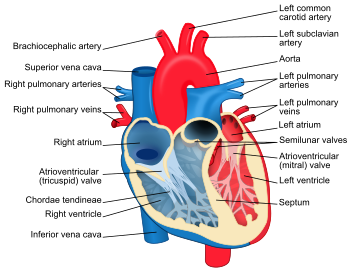Structure
The structure of the heart varies among the different branches of the animal kingdom. (See Circulatory system.) Cephalopods have two "gill hearts" and one "systemic heart". In vertebrates, the heart lies in the anterior part of the body cavity, dorsal to the gut. It is always surrounded by a pericardium, which is usually a distinct structure, but may be continuous with the peritoneum in jawless and cartilaginous fish. Hagfishes, uniquely among vertebrates, also possess a second heart-like structure in the tail.[8]
In humans
The human heart has a mass of between 250 and 350 grams and is about the size of a fist.[9] It is located anterior to the vertebral column and posterior to the sternum.
It is enclosed in a double-walled sac called the pericardium. The superficial part of this sac is called the fibrous pericardium. This sac protects the heart, anchors its surrounding structures, and prevents overfilling of the heart with blood.
The outer wall of the human heart is composed of three layers. The outer layer is called the epicardium, or visceral pericardium since it is also the inner wall of the pericardium. The middle layer is called themyocardium and is composed of muscle which contracts. The inner layer is called the endocardium and is in contact with the blood that the heart pumps. Also, it merges with the inner lining (endothelium) of blood vessels and covers heart valves.[10]
The human heart has four chambers, two superior atria and two inferior ventricles. The atria are the receiving chambers and the ventricles are the discharging chambers. The pathway of blood through the human heart consists of a pulmonary circuit[11] and a systemic circuit. Deoxygenated blood flows through the heart in one direction, entering through the superior vena cava into the right atrium and is pumped through the tricuspid valve into the right ventricle before being pumped out through thepulmonary valve to the pulmonary arteries into the lungs. It returns from the lungs through thepulmonary veins to the left atrium where it is pumped through the mitral valve into the left ventriclebefore leaving through the aortic valve to the aorta

No comments:
Post a Comment